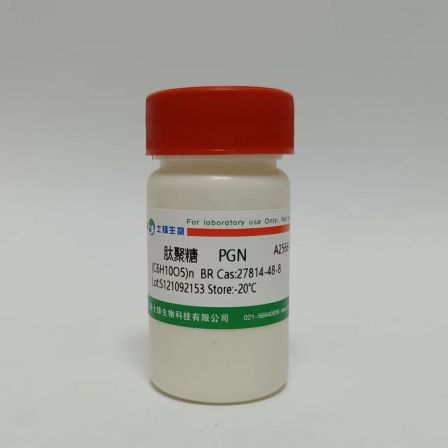
英文名称:PGN;Peptidoglycan
CAS号:27814-48-8
分子式:(C6H10O5)n
性状(以下信息仅供参考):咖啡色或褐色冻干粉。酵母菌或大肠杆菌中提取,溶于水:1mg/ml
用途:本品仅供科研,不得用于其它用途
保存:-20℃
Most bacteria have a cell wall containing a special polymer called peptidoglycan. Over the cell membrane is a shift of peptidoglycan and other polymers including teichoic and teichuronic acids. This peptidoglycan gives a certain rigidity to the cell wall and gives the cell mechanical strength. The bacterial cell wall is a unique biopolymer, it contains both D- and L-amino acids. Its basic structure is a carbohydrate backbone of alternating units of N-acetyl glucosamine and N-acetyl muramic acid. The N-acetyl muramic acid residues are cross-linked with oligopeptides. The terminal peptide is D-alanine although other amino acids are present as D- isomers. This is the only known biological molecule that contains D-amino acids and it is the target of numerous antibacterial antibiotics e.g. pencillin. Penicicllin inhibits the enzymes transpeptidase and carboxypeptidase, which are responsible for the building of peptidoglycan. Lysozyme, present in the tears liquid, is able to split the peptidoglycan between the N-acetyl glucosamine and N-acetyl muramic. The cell wall of Gram-positive bacteria is largely made up of pepidoglycan. There may be up to 40 layers of this polymer, conferring enormous mechanical strength on the cell wall. [3] The primary immune recognition is based on structures common among invading pathogens. Surface molecules, such as lipopolysaccharide (LPS), peptidoglycan and peptidoglycan recognition protein (PGRP), are known to elicit immune reactions ranging from cytokine release to fever. [4-6] Applications: Used for the activity estimation of lytical enzymes (e.g. Lyticase). All peptidoglycan can be used for this purpose but can be used as chromogenic substrate for lytical enzymes. [1] It is recommended to use a peptidoglycan concentration of 0.15 – 3mg/l in water or buffer and measuring at 450 nm. The peptidoglycan can not be solubilized but it is possible to make a suspension. For the peptidoglycan dyed with remazol brilliant blue R a possible working suspension is 3 mg/l glycin-buffer (0.2M, pH 10) which cam be measured at 595 nm. [7] For the stimulation of lymphocytes: Peptidoglycan activates the Toll-like receptor 2 (TLR2), present in mammalian cells. Work as an antagonist of Poly (I:C).[2]

肽聚糖
oxiran-2-ylmethyl nitrate;Nsc137875;Oxiranemethanol, nitrate;2-oxiranemethanol, nitrate;2-Oxiranylmethyl nitrate;Glycidyl nitrate homopolymer




